 |
Home Info History Transportation Restaurants Top-10 Events Nightlife Walks Safety Photos
Wine  |
The excellent geographical location of Madrid within the Iberian Peninsula makes it ideal to move not only around the capital's surroundings, but also allows the traveler to easily reach almost every corner of Spain. On this page you will find a comprehensive description of the most relevant sites to visit and advice on how to get there.
EL ESCORIAL
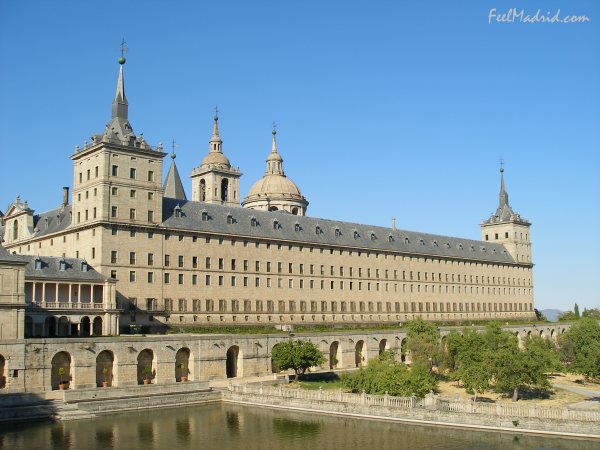
The Royal Monastery of San Lorenzo de El Escorial.
The Monastery of El Escorial, located some 30 miles northwest of Madrid in the foothills of the Sierra de Guadarrama, was built as a monument to commemorate the Spanish victory over the French in the battle of Saint Quentin on 10 August 1557 (feast day of St. Lawrence). Felipe II himself selected the site for the monastery, 1,028 meters (3,372 feet) above sea level, and personally oversaw the progress of the project. The monastery was initially designed by architect Juan Bautista de Toledo, but after his death in 1567, his assistant Juan de Herrera continued the work. Construction lasted 21 years from 1563 to 1584, and for many years after its completion, El Escorial Monastery was the largest building in the world.
Read more about the Monastery of El Escorial Here.
Visiting the Monastery.
El Escorial can be reached from Madrid either by bus from Moncloa (lines 664 and 661), or by train from Atocha and Chamartín Stations.
Visiting Times:
October-March: From 10:00 am to 17:00 pm.
April-September: From 10:00 am to 18:00 pm.
Mondays closed.
Entrance fees: 8 Euros.
Wednesdays: Free for EU Citizens.
Telephone for information: (+34) 91 890 59 04
Telephone for reservations: (+34) 91 890 59 05
Website: http://www.patrimonionacional.es
THE VALLEY OF THE FALLEN
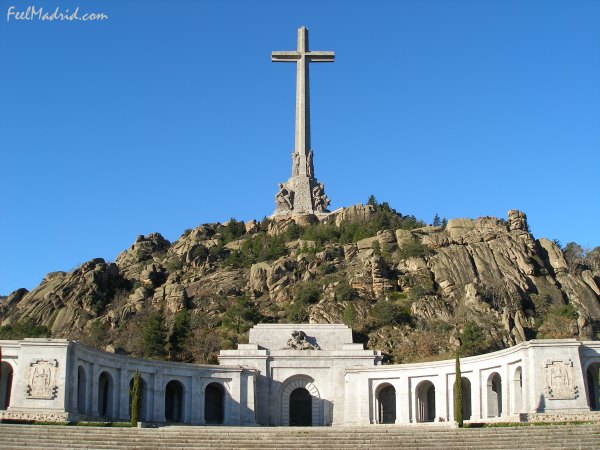
The Valley of the Fallen.
The Valley of the Fallen (Valle de los Caídos) is located in the Sierra de Guadarrama some 8 miles north of El Escorial. The complex was built between 1940 and 1958 and is a monument intended to commemorate all those who died on both sides during the Spanish Civil War (1936-1939). About 40,000 Nationalist and Republican soldiers are buried here. However, the Valley of the Fallen is inevitably associated with Franco's regime since the late General is buried inside the basilica and he was the one who ordered its construction. Nevertheless, it is an impressive place that was visited by about 450,000 people in 2005.
Read more about the Valley of the Fallen Here.
Visiting the Valley of the Fallen.
The Valley of the Fallen can be reached from Madrid by bus from the Moncloa Interchange. The buses of the line 664 (Autocares Herranz) take you to the entrance gate of the Valley in about 45 minutes (Cruce de Cuelgamuros stop). Also, from the bus station in the town of San Lorenzo de El Escorial, line 660 takes you to the Cruce de Cuelgamuros as well. Once you arrive at the entrance gate, there are still about three miles uphill to the cross, so unless someone is kind enough to give you a ride, be ready to walk.
Visiting Times:
October-March: From 10:00 am to 17:00 pm.
April-September: From 10:00 am to 18:00 pm.
Mondays closed.
Entrance fees: 5.00 Euros.
Funicular railway: 1.50 Euros.
Wednesdays: Free entrance for EU Citizens.
Telephones: (+34) 91 890 56 11 and (+34) 91 890 13 98
Website: http://www.patrimonionacional.es
MANZANARES EL REAL
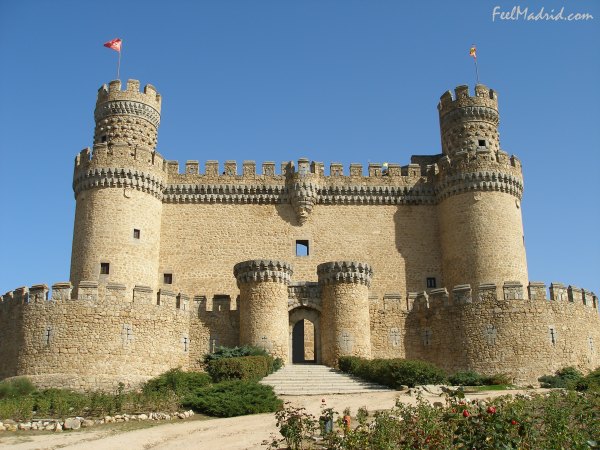
The castle of Manzanares el Real.
The town of Manzanares el Real, 30 miles north of Madrid, is most famous for its castle that is an imposing example of the military architecture of the 15th century in Spain. The construction of the castle began in the year 1475, at a time when Madrid had little more than 100 houses and about 300 citizens. The castle has a quadrangular plant with four towers on the corners. Three cylindrical towers and a larger one known as Torre del Homenaje (Homage Tower) with a squared layout. Each of the three cylindrical towers is crowned with smaller towers, and the "Homage Tower" is finished off with another smaller octagonal tower. The body of the castle has sides of 30 meters and the cylindrical towers have a diameter of 6.5 meters at the base. The central courtyard (called Patio de Armas) is surrounded by corridors with arcades as an example of the late Gothic style with Mudejar influence. Finally, the castle is surrounded by a barbican wall with a single entrance through a beautiful gate facing the west side and flanked by two solid towers. All the walls of the barbican have arrow loops in the shape of the cross of Jesusalem.
Read more about the Castle of Manzanares el Real Here.
Visiting the castle of Manzanares el Real.
The town of Manzanares el Real can be reached from Madrid by bus from Plaza de Castilla Station (line 724). The trip from Madrid takes about 50 minutes and costs 3 Euros.
Visiting Times:
October-May: From 10:00 am to 17:00 pm.
June-September: From 10:00 am to 18:00 pm.
Mondays closed.
Entrance fees: 2 Euros.
TOLEDO
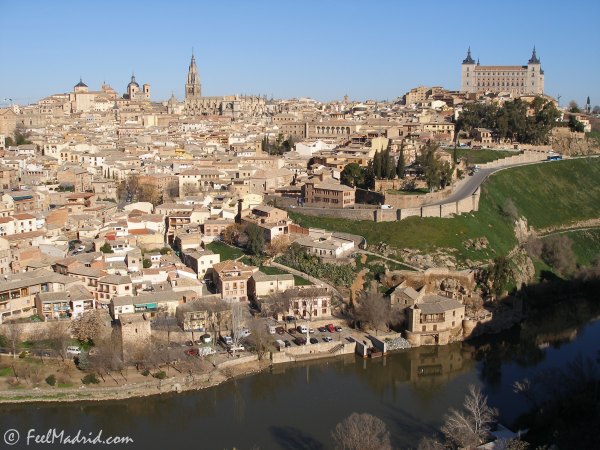
A view of Toledo.
Toledo, also known as the Imperial City, is located 44 miles southwest of Madrid and is one of the most visited sites in Spain. Partially surrounded by the Río Tajo (Tagus River), the city has a population of 75,578 (2005). In 1986, Toledo was declared a World Heritage Site by UNESCO.
Toledo was well established before it was conquered by the Romans in 192 BC. Roman Toletum was the provincial capital of Carpetania. Later the city served as capital of the Visigothic kingdom from the middle of the 6th century until it was captured by the Moors in 712. Under Muslim rule, Toledo attained cultural and economic preeminence. In 1085, Alfonso VI reconquered the city from the Moors and shortly after Toledo became the capital of Castile. Christian, Muslim, and Jewish cultures blended in medieval Toledo making it a model of co-existence, and aided in the transmission of classical learning to western Europe. During the 16th century Toledo was the capital of united Spain, but in 1561 Felipe II moved the court to Madrid and the city began to decline. The city was a battleground during the War of the Spanish Succession (1701-14), the Peninsular War (1808-14), and the Spanish Civil War (1936), when the Alcázar was defended by the Nationalist forces.
Read more about Toledo Here.
Visiting Toledo.
The easiest and fastest way to get to Toledo from Madrid is by train from Atocha station. It takes just 30 minutes for the AVE (High Speed Train) to arrive at Toledo, and a return ticket costs 13.75 Euros. Toledo's train station (Paseo de la Rosa s/n) is only a five minute walk away from the Puente de Alcántara. The best place to begin an exploration of the city on foot is the triangular Plaza del Zocodover that is Toledo's most important square and a popular meeting point.
SEGOVIA
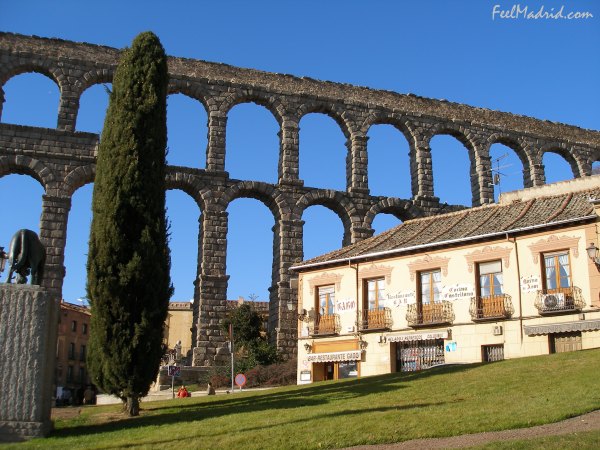
The Roman Aqueduct of Segovia.
Full of charm and history, the city of Segovia is located 53 miles northwest of Madrid, high above the Castilian plane at the confluence of the rivers Eresma and Clamores. Segovia has a population of 57,617 (2005) and is visited by thousands of people every year. Main attractions include the Roman Aqueduct, the Alcázar, and the 16th century Gothic cathedral. There are also more than 20 old Romanesque churches, convents, and monasteries spread all over the city and its surroundings, although most monuments are concentrated in the medieval urban center within the old city walls.
In December 1985, the old town of Segovia and its Aqueduct were declared World Heritage Sites by UNESCO.
Read more about Segovia Here.
Visiting Segovia
Segovia can be reached from Madrid by train from Atocha and Chamartín stations. It takes about 2 hours to get to Segovia and a return ticket costs 10.20 Euros. Once you arrive at Segovia's train station, a bus (line 8) will take you to the Roman aqueduct in a few minutes. Go to the tourist information office located at the Plaza del Azoguejo right below the aqueduct, get a map if you don't have one already, and begin exploring the city by yourself. The main tourist route runs between the Roman Aqueduct and the Alcázar, and since many streets have been pedestrianized walking is the best option.
| Home Info History Transportation Restaurants Top-10 Events Nightlife Walks Safety Photos Wine Quiz Contact |

